Five Reasons to Buy Climbing Magazines
There's nothing better than turning off you devices and sitting down with magazine full of stories with engaging photos

The sport of climbing has had an online presence for nearly 30 years and one thing is certain, digital climbing media does not replace print. Many people thought that one day all of the climbing publications would be solely available online. The pros to online and social media are that they allow for quick news reports and for every climber to share their stories and photos. The cons are that online reports, websites and social media posts can and are deleted, which removes the record. Below are five reasons why printed climbing magazines are better.
1. Magazines Last Longer: As the internet changes, old stories and photos become outdated and are lost to cyberspace. Many important climbing reports that were only available on the internet are now gone. Whatever you post on social media likely won’t be there in 20 years. Anyone who has a collection of magazines can look through them at any time, re-reading old stories and news reports. The little amount of space needed to store a magazine collection is worth it. There is nothing better than turning the screen off and flipping through the pages of old climbing magazines.

2. Better Stories: While online media started with the intention of providing the best material, the demand for quick reads, social media and clickbait stories has drowned it out. Not to say that online content isn’t good, it’s just not great. Even if you find good writing, the layout of a webpage does not allow the designer to create the most optimal story that flows with the words and photos, often because of now-boring preset web templates. Magazines use professional designers to blend words and photos in a way that builds a unique story.
3. Better Photos: The internet is full of great images that are shared on platforms such as Instagram, Twitter and Facebook. The main difference between a photo on your screen and that in a magazine is the resolution. Most online photos are such low resolution that you couldn’t print it in a magazine. Printed images are better defined and higher quality. Online images can always be manipulated and over time shrink in file size.
4. Support the Industry: The climbing industry is made up of many parts, such as equipment manufacturers, apparel brands, gyms, clubs, access committees, competition organizers, teams, media and many more. Some companies are big enough to sponsor/support climbers with free gear, money or travel funds. As climbing is still a relatively small sport, every part of the industry is connected in some way. By supporting any part of it, you support the other parts. Buying magazines allows them to pay writers and photographers for their content, which inspires others to go climb. While many climbing brands have their own online media for their athletes, magazines are unbiased in who makes their pages and therefore give a better idea of the climbing scene as a whole.
5. More Motivating: There is no doubt that flipping through any of the many climbing magazines or journals that you’ll find something that motivates you. Scrolling through screens, you see endless content, so it’s hard to absorb anything. Countless big climbs and first ascents took place because a climber picked up a magazine. Most climbers who have been around for long enough can picture their favourite cover and remember the story that inspired their first road trip. The internet complements print publishing, but it won’t replace it – at least for climbers.



